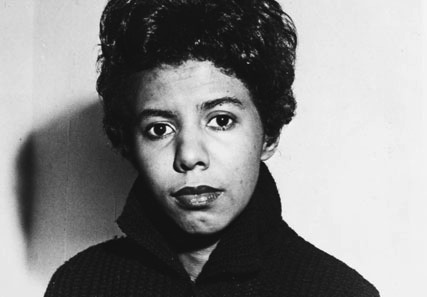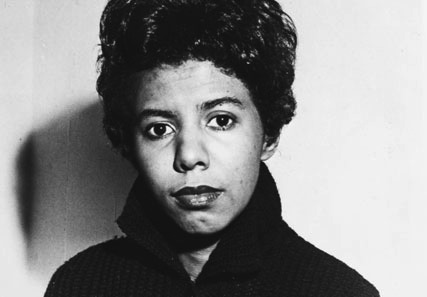

Lorraine Hansberry is best known for writing A Raisin in the Sun, the first play by an African American woman produced on Broadway. Lorraine Hansberry’s parents were both active in the black community in Chicago, including in social change work. Her uncle, William Leo Hansberry, studied African history. Visitors to the home included Duke Ellington, Paul Robeson, and Jesse Owens. Her family moved, desegregating a white neighborhood with a restrictive covenant, in 1938, and though there were violent protests, they did not move until a court ordered them to do so.
The case made it to the U.S. Supreme Court as Hansberry vs. Lee, when restrictive covenants were ruled illegal (which did not stop enforcement of them in Chicago and other cities).
Lorraine Hansberry attended the University of Wisconsin for two years, then left to work for Paul Robeson’s newspaper, Freedom, first as a writer and then associate editor. She attended the Intercontinental Peace Congress in Montevideo, Uruguay, in 1952, when Paul Robeson was denied a passport to attend. She met Robert Nemiroff on a picket line, and they were married in 1953, spending the night before their wedding protesting the execution of the Rosenbergs. Lorraine Hansberry left her position at Freedom, focusing mostly on her writing and taking a few temporary jobs.
“What happens to a dream deferred?
Does it dry up like a raisin in the sun?
Or fester like a sore — and then run?”
She began to circulate the play, Raisin in the Sun, trying to interest producers, investors, and actors. Sidney Poitier expressed interest in taking the part of the son, and soon a director and other actors (including Louis Gossett, Ruby Dee, and Ossie buy viagra for male Davis) were committed to the performance. Raisin in the Sun opened on Broadway at the Barrymore Theatre on March 11, 1959.
The play, with themes both universally human and specifically about racial discrimination and sexist attitudes, was successful, and a screenplay soon followed in which Lorraine Hansberry added more scenes to the story — none of which Columbia Pictures allowed into the film.
Lorraine Hansberry was commissioned to write a television drama on slavery, which she completed as The Drinking Gourd, but it was not produced—NBC executives apparently didn’t support the idea of a black screenwriter writing about slavery. Moving with her husband to Croton-on-Hudson, Lorraine Hansberry continued not only her writing but also her involvement with civil rights and other political protest, even after being diagnosed with cancer. In 1964, The Movement: Documentary of a Struggle for Equality was published for SNCC (Student Nonviolent Coordinating Committee) with text by Hansberry. She divorced Nemiroff in March, though they continued to work together.
In October, Lorraine Hansberry moved back into New York City as her new play, The Sign in Sidney Brustein’s Window began rehearsals. Although critical reception was cool, supporters kept it running until Lorraine Hansberry’s death in January.
After her death, her ex-husband finished her work on a play centered on Africa, Les Blancs. He also collected Hansberry’s unpublished writings, speeches and journal entries and presented them in the autobiographical montage To Be Young, Gifted and Black. The title is taken from a speech given by Hansberry in May 1964 to winners of a United Negro Fund writing competition: “…though it be thrilling and marvelous thing to be merely young and gifted in such times, it is doubly so, doubly dynamic, to be young, gifted and black!”
